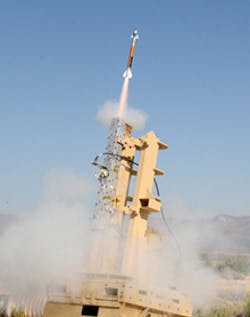BETHESDA, Md., 8 June 2012. Lockheed Martin’s [NYSE: LMT] Extended Area Protection and Survivability Integrated Demonstration (EAPS ID) program successfully conducted a Controlled Test Vehicle flight test on May 26 at White Sands Missile Range, N.M.
The test was conducted in collaboration with the U.S. Army Research Development & Engineering Command/Aviation Missile Research Development & Engineering Center (RDECOM/AMRDEC).
The Lockheed Martin EAPS system uses a miniature hit-to-kill (MHTK) interceptor that defeats rocket, artillery and mortar (RAM) targets at longer ranges than those of current systems. During the flight test, the tactically configured MHTK interceptor was launched vertically and then performed a series of maneuvers to demonstrate required performance while capturing data. The data collected will support guided flight tests against live RAM targets beginning in the second half of 2012.
In April the EAPS system was tested on its ability to track RAM targets. During the April tests, the EAPS fire control sensors provided target track information sufficient to conduct a full target engagement sequence, including the issuance of a launch command followed by a simulated EAPS missile fly-out and simulated intercept.
The Lockheed Martin EAPS round is an agile, small hit-to-kill interceptor that weighs approximately seven pounds. It is less than two inches in diameter and less than 3.3 feet long. Paired with a fire control sensor, EAPS defeats targets through body-to-body impact at range.
Lockheed Martin’s EAPS features support for multiple launchers and fire control sensors. This capability increases the protected operational environment, providing soldiers protection and flexibility when compared to legacy and interim systems.
